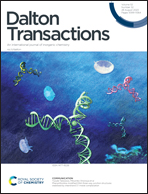2-Chloroethylamine·trifluoromethanesulfonate combined with 18-crown-6: a ferroelectric with excellent dielectric switching properties†
Abstract
Ferroelectric materials are not only important electronic functional materials, but also considered as the most promising intelligent basic materials, because they show good application prospects. Therefore, it is an urgent task to develop and explore new ferroelectric material systems. In addition, the most important feature of crown ethers is their ability to complex with positive ions, which is extremely useful in synthesis. We report that [NH3C2H4Cl(18-crown-6)](CF3SO3) (1) has a phase transition temperature Tc = 255 K, and there is an obvious SHG switch below Tc. At the same time, the saturation polarization value Ps = 1.25 μC cm−2 is obtained from the hysteresis loop, which directly proves the ferroelectric nature of compound 1. It is noteworthy that the second harmonic response test of compound 1 shows a symmetric transition from a non-centrosymmetric to a centrosymmetric point group, that is a symmetry break from the paraelectric phase to the ferroelectric phase. This work is expected to promote the further exploration of organic crown ether ferroelectrics and provide a way to design and synthesize organic crown ether ferroelectrics.



 Please wait while we load your content...
Please wait while we load your content...